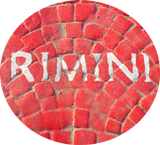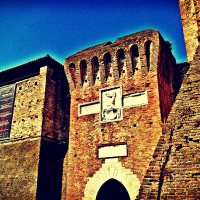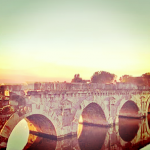The Ciambella
Like its close companion, the piadina, the ciambella is on first glance a very simple and uninspiring food – a type of plain oven-baked cake made from flour, eggs, sugar, yeast, milk, butter, and, perhaps, a touch of lemon zest. In its simplicity, though, it has become one of those characteristic and important foods of the Romagna region. Its become a symbol for both a past in danger of slipping away, and for the regional obsession with detail – you can’t find a good ciambella everywhere, you have to go amongst the region’s more traditional bakeries to find one done well.
The ciambella is also a key to discovering the traditions and past of this region. Traditionally it was baked for Easter, and is forever associated in enthusiasts’ minds with Easter breakfast where it would be eaten alongside the first ready seasoned salami (pigs would be traditionally slaughtered in December/January, and so the first cured meats would not be ready before Easter), hard-boiled (and usually blessed – as well as decorated), and accompanied by a sweet white wine (usually an Albana di Romagna, although there are connosieurs who suggest that there’s nothing better than a slice of ciambella accompanied by a locally produced Rebola).
Part, then, of the appeal of the ciambella was its out-of-the-ordinariness. It was eaten rarely, and so, while relatively simple as desserts go, it was appreciated profoundly. There were two main reasons for its rarity. First, it was a rich dessert in terms of ingredients. The economy around Rimini was traditionally rural and poor, made up of small landholders or families who lived and worked the land for larger land-owners. A daily breakfast including eggs, sugar, yeast,butter, milk, lemon and salami would have been an unthinkable luxury. The second reason is that it was an oven-baked dish, and many – perhaps most – houses did not posess an oven in which to bake the ciambella. Instead, at Eastertime the local bakery would put its ovens at the service of local Azdore (the Azdora was the head-woman of a household), who would bring their ready prepared mixtures to bake.
The name ciambella has a number of possible etymologies – the most popular is from the latin cymbula, meaning little-boat. In fact, in modern Italian a life-ring is known as a ciambella. Another suggestion is that it comes from suavillum and suavis, meaning something like sweet to taste – Cato in his writings described a type of cake called suavillum made of eggs, cheese, honey, and flour.
The ciambella per se is not specifically Romagnolo – it’s found in other parts of Emilia-Romagna (for example in Bologna and Parma), and in other regions. The Ciambella Romagnola though does have a unique characteristic – it’s the only one that is baked without the hole in the centre. Instead it is baked whole with the shape of an ellipse.
Nowadays the tradition of baking your own ciambella, albeit using the Baker’s oven, has largely died out. Homes have ovens now, but the humble ciambella has to compete with ready-made delights from the supermarket shelves, cereals and suchlike. Restaurants have also largely ignored the dessert, presuming that dolci should be fancy things that aren’t easily made at home, like profiteroles, zuppa inglese, semi-freddi and gelato. Where does that leave the ciambella? Well, in a certain sense it protects its value, becoming a thing that needs to be actively sought out – something, like the white truffles found in the hills, that tastes all the better for the search. The place where you’re most likely to find a good ciambella are in a) old-style bakeries in the small towns that dot the hills and countryside of the province of Rimini, and b) in the more rustic family-run osterie restaurants far-away from the tourist trail (wrongly, in our view, restaurant owners who cater to tourists presume that they’ll be dissapointed with something as no-frills as a ciambella).






